Without a doubt the old Silver faced Pioneer Receivers from the 70’s and 80’s was some of the most epic stereo gear ever designed. Sadly with the advent of cell phones and tablets everybody listens to their music on cheap earbuds while streaming low res music from some far away server.
Well not everybody does that. But most. And that means all those old boat anchor sized amps are in the back of the closet, the garage, in the attic and turn up at the estate sale from time to time.
Stupid old guys like me who are trying to relive their childhood will pay top dollar for an old amp that realistically time forgot. So these days it becomes the challenge of the old audiophile (audiophool) to find one cheap and bring it back to it’s once epic status.
So I scour yard sales, local classified ads, eBay, Letgo, and Craigslist looking for the person who has one who doesn’t know that some 50 year old men will hawk their children for one yet. So I found an old Pioneer SX-650 on my local Craigslist that wasn’t too expensive. The SX-650 seems to have been made between 1976 and 1978 and is 35 watts per channel. All the relevant information about it can be found here and manuals can be downloaded as well provided you create an account.
Here’s my score and I’ve obviously removed the wooden case here. It’s hard to tell from the picture but it has a thick film of yellow cigarette smoke on everything.
“Rule 1: Never take a 40 year old amp in your house and leave it. You have no idea what is living inside. Open it up outside and clean it! You’ve been warned.”

In addition to that it looks like a dust factory on the inside.
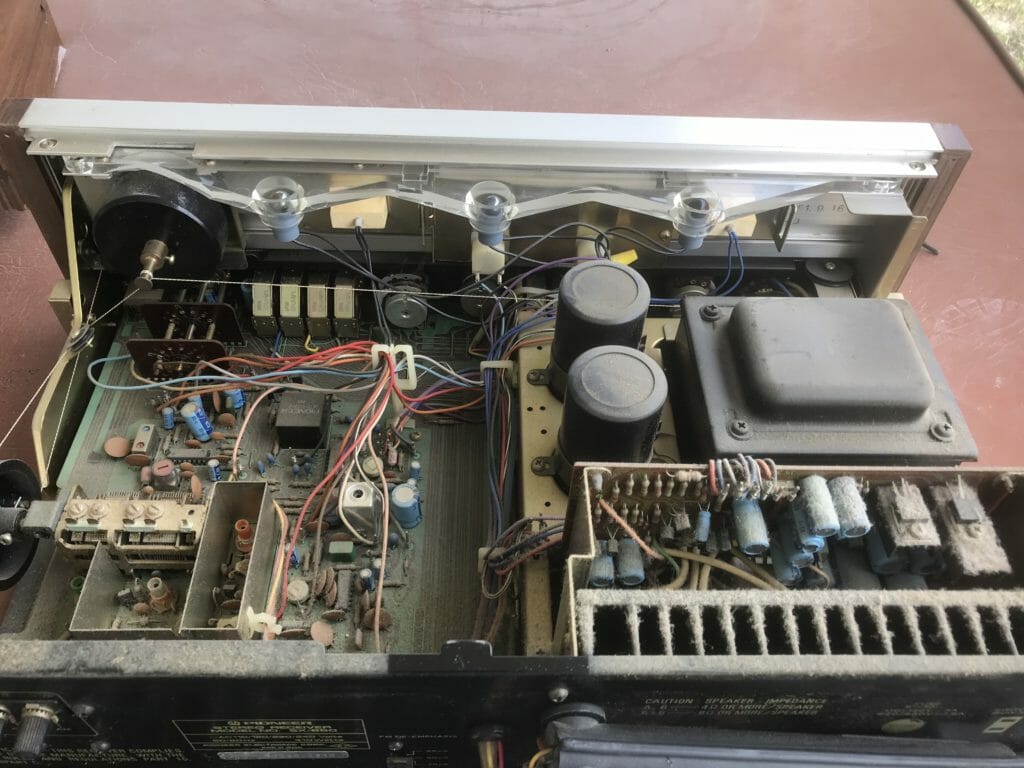
That’s 40 years of dust right there folks. Other than that though when I picked it up the seller had it working. I tested all the functions and they appeared to be working fine. It’s kind of amazing nothing shorted out though. I had to drop $120 for this but he wanted $150. I tried for $100 but 120 was as good as it got. No biggee. I just have to take care to not put too much money into this in case I want to flip it.
The first thing to do is to clean this dust so I can see what I’m up against if anything. The first thing I did was to take a very long and soft bristled paint brush to remove the massive dust products. Following that I used contact cleaner with a fast evaporation rate. You want to exercise some care when spraying that because there are some places it shouldn’t go, but for the most part you can blast away. The initial clean up turned out great.

Now I can actually see what I’m up against. Took me about 30 minutes or so to safely and carefully clean everything. Once the heavy deposits were gone I used a soft brush again and in stubborn areas used a small toothbrush with isopropyl alcohol. Really worked good in the corners and flat surfaces around hardware. I did a real good job here.
Now, we visually inspect and THEN power up. I see no evidence of bulged or leaking capacitors. No broken components ……. all is well. I apply power and only one panel light lights up. That’s okay. I have something for that too. I removed the old soldered in glass incandescent lamp and soldered in a new T10 5 watt LED lamp.

It doesn’t matter which direction you solder in the LED, just tack one wire onto each side of the LED. Just tack them against the wire. Doesn’t take much solder or heat. You might melt the housing a tad but it won’t hurt anything. I changed out all 3 panel lamps. You can also solder in various colors and intensities of LED’s as well.
All these T10 5 watt LED’s say that they are for 12 volt systems however they have voltage regulators in them. They’ll work fine with whatever voltage you feed it within reason. The Pioneer lamp voltage should be 7.5 volts as per the service manual. The 12 volt T10 LED’s will work just fine here.
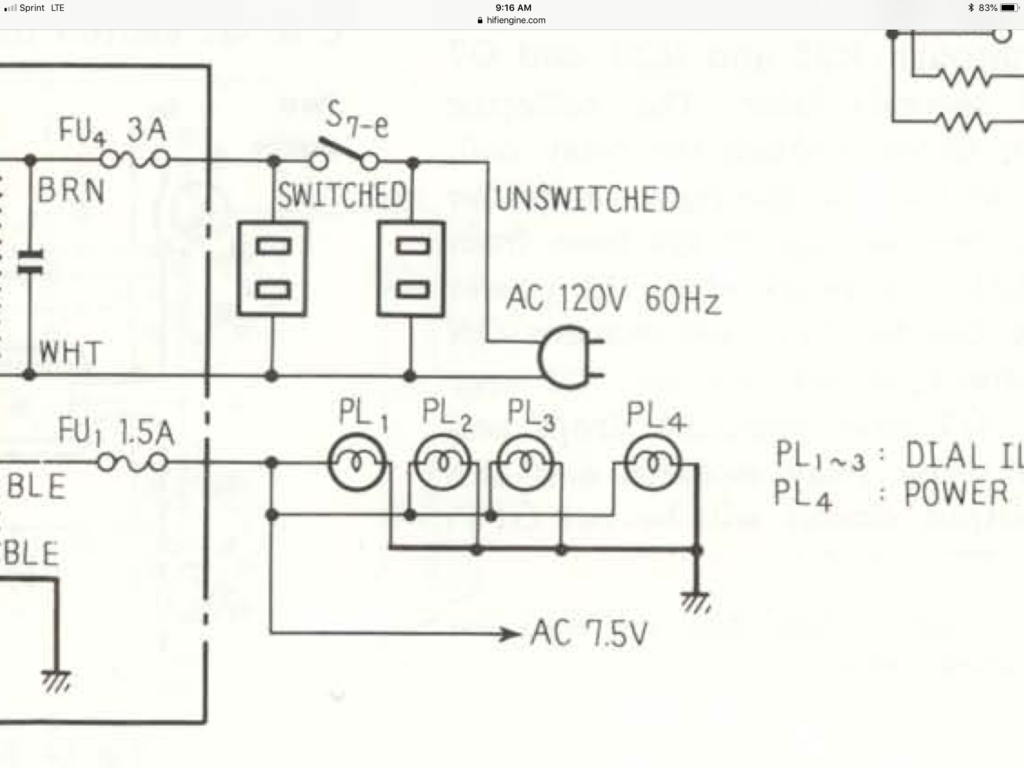
Now lets shoot contact cleaner in all the open switches and dials. Work back and forth, repeat a time or two letting it dry between applications. Now you need to lubricate the contacts. Most stereo guys use something called DeOxIt and while I have some of that I used a Mil-Spec Avionics Corrosion Compound, Mil-PRF-81309. Only about a thousand times better than DeOxIt. You can buy Mil-PRF-81309 on line however many companies that make it don’t qualify for the Mil-Spec to sell it to the military. Check something called the Qualified Product Database or QPD for short. Or buy some DeOxIt.
All done inside for now. Now to tackle the yellow nicotine tar on the outside. First thing I did was remove all the knobs and put them in a bowl of soapy water with a splash of isopropyl alcohol and let it soak for a bit. Then I took a toothbrush dipped in isopropyl alcohol and scrubbed the heavy stains off. This has a tendency to just rub the yellow around so you’ll have to come back later with a towel and some isopropyl alcohol for a final wipe. Might take a couple of passes. Then brush the dials, wipe the glass and reassemble the case. My case needs new veneer. That’ll have to wait for a long weekend or something.

And it works too!
Round 2: Stripped the old veneer paper off of the case and removed the front blocks getting ready to bring the case back up to speed again. Couple people asked me how I got the face plate blocks off. Nothing to it. Pull off every switch and knob hardware and there are two screws inside on top that hold the faceplate on. Once the faceplate is off there are three small wood screws on each block. Couldn’t be easier to remove them.
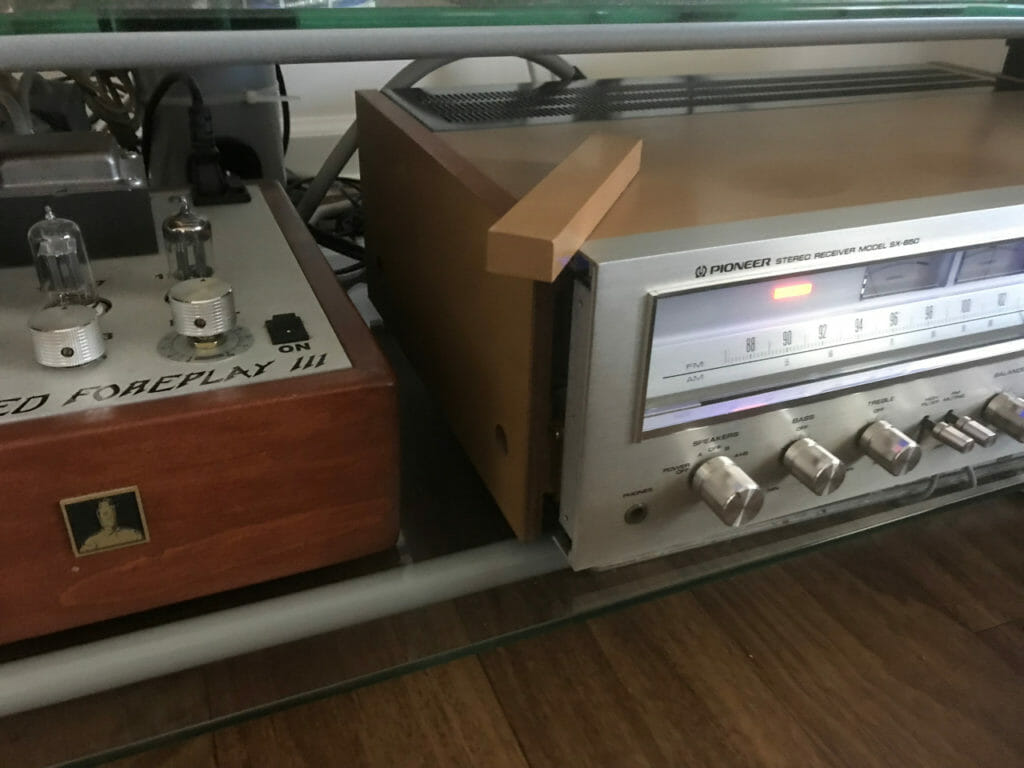
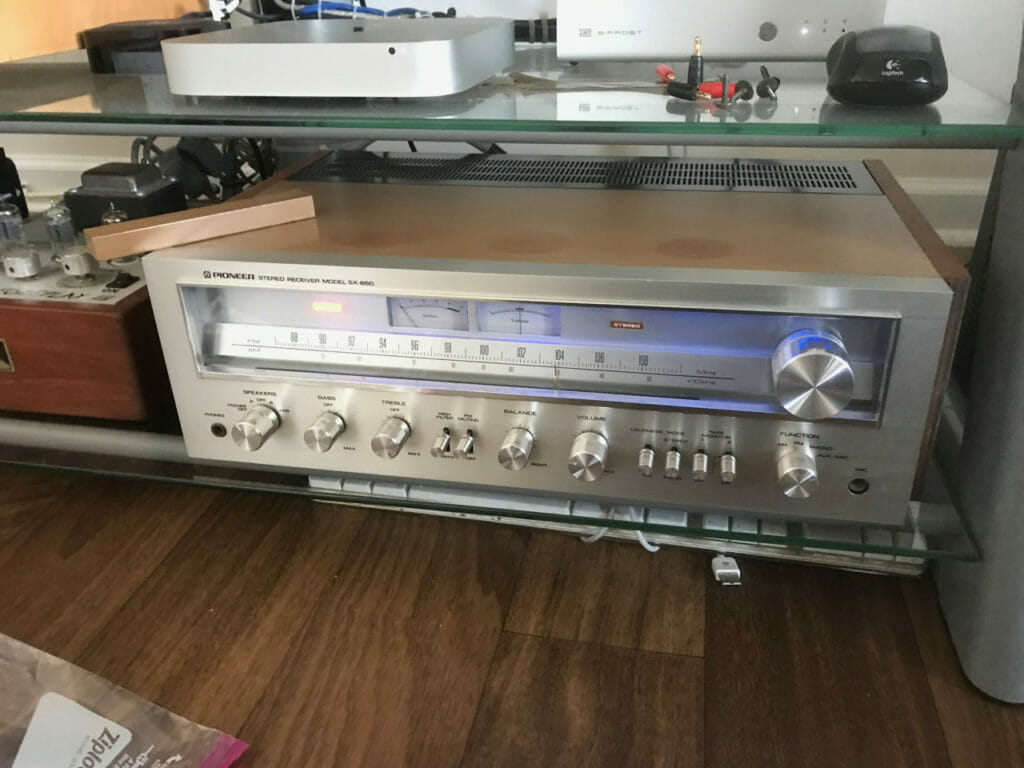
Ordered some Cherry Pressure Sensitive Adhesive Veneer off of Amazon which should be here in a few days. I’ve never veneered anything before however everything is a rectangle so it shouldn’t be too awful.
Added the veneer which turned out to be fairly easy then switched the LED’s back from blue to white to maintain the vintage look.

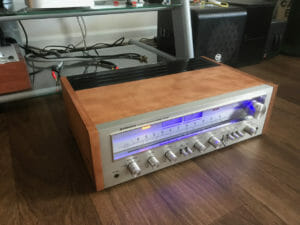
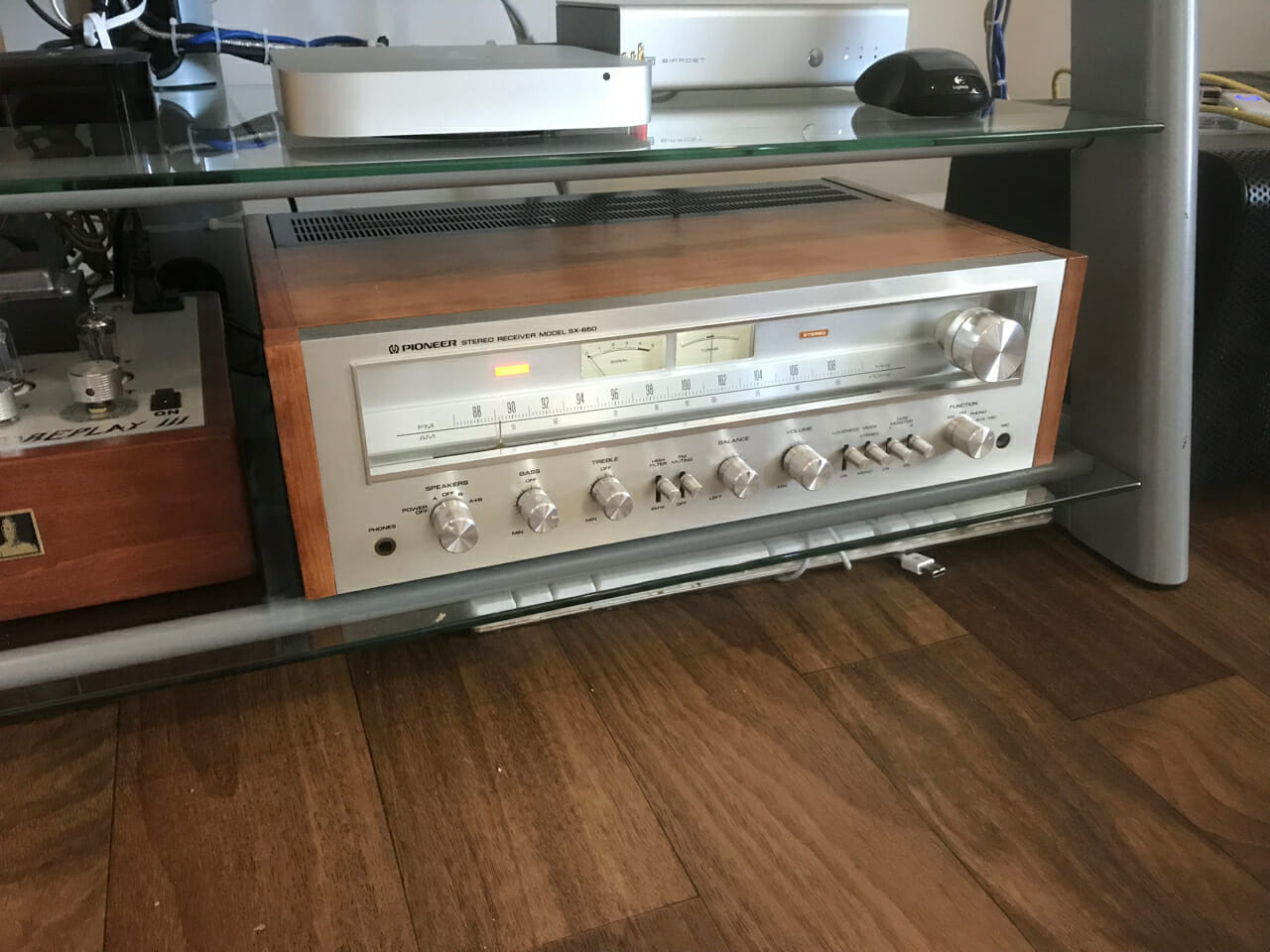
And here’s a quick video of it working.

I feel a bit guilty about paying 40 dollars for my Pioneer SX650 last night. The wood case was replaced with sheet metal case..looks ok, but just not me. Thinking about what type of case to replace it wtih. Inside was dirty, took your advice and cleaned it outside. Cleaned up well and sounds great. Just need to check speaker voitage output today. Facebook Marketplace has been good to me the last few weeks. Got a Pioneer SX850 a few weeks ago for $100 dollars from original owner but the speaker relay needed to be replaced. He was a great seller and found the original documents and dropped them off.
All in all, the hunt for these old stereo/receivers is a bit of fun. Found Fisher 400/500B/C, Marantz 2216/2325/2226. All very good prices, all working.
The dealers are like a pack of wolves and hard to beat to the sale but still a bit of fun
I bought a Pioneer SX-650 and paid $90.00 + 25.00 shipping from Ebay, The unit was in pretty good shape. I did the CRC electrical spray cleaner and high pressured air cleaning. All the dashpots worked and it sounded really good. About 6 or 8 months later the overload relay started clicking the system off…Nuts! So I looked at the circuit board and found a cold solder joint. I tacked it with some solder and it worked again for another six months and then the same thing. I am not a electronic tech so my field of knowledge is limited. A year went by and I just couldn’t get it out of my head! I needed another one…Let’s face it to recap and change output transistors is out of my league and I couldn’t find anyone local that did it for less than $250 so I decided to roll the dice and find another one. Oh happy day! I found one for $70 + 25.00 shipping without knobs and veneer that had seen better days. However my old one had the necessary goodies if this amp works when it arrives. The ad said that it had been plugged in and lights up. Close enough for me! When it arrived a week later I took out the AR 4xa speakers and hooked them in. With the top off I noticed it looks like all the capacitors were either replaced or phenomenally perfect without bulges. At first I left the volume down and the bass and treble down. I turned on the 650 and it arose to a lit condition…Hearing the relay click excited me! So as I reached for the volume stem ( hadn’t got around to removing the knobs from the old one yet) I cranked it up slowly. Static! beautiful static! So I scrambled to fine an fm antenna and proceeded to hook it up, then scan the channels. The channel knob and needle moved flawlessly…coasting with a twist so effortlessly…Finally I find the “I got one!” needle shows a strong channel and the stereo lite is lit. Saints preserve us…Now to jack up the volume a bit…What is that?!? A commercial! nuts…there is always a commercial. But sound!… it’s coming out of both speakers. Finally some oldies are playing, I cranked up the AR’s and turned the bass and treble up half way. I let it play for several hours. It has now been “knobed” and the other veneer cover is in place. Now the loudness switch is approved for use and full bass and “wife annoying” treble has permeated the4 corners of the home! AS I know it is 45 years old I believe I will leave the bass and loudness to a more capacitor forgiving level…So I just bought a Pioneer PL-117D turntable missing parts for $90.00 shipped. It took awhile to get the headshell and cartridge and a new belt but it now is playing my favorite tunes from my yesteryear.. I have ordered a dust cover however it is from a different Pioneer. The cover will fit however I may have to “re-invent the hinges, I will see when they arrive. But at 69 years old not remembering what the heck I did with the ones I brought back from Alaska (the only thing original is the AR’s but with replacement authorized 8″ woofers, bit still the original crossovers and tweeters) I just felt the need to do as you say, go back to the salad days and now all I need is my 1970 340 ‘Cuda to come home…”Where are you car!!” Hump, no answer. Oh well now where is my Pink Floyd album?